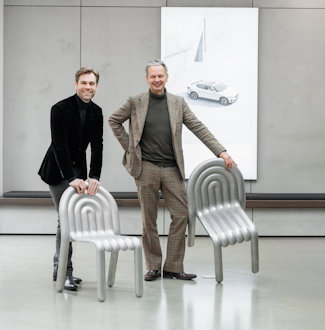Zero-carbon aluminium for more sustainable car production
Carmakers across the world want to build greener cars with materials and manufacturing practices that are considered sustainable. How to achieve this is one question. Another is how recycled aluminium can fit into their plans. Polestar’s collaboration with Hydro could answer both questions.
Polestar is a youngster in the automotive industry, having been founded in 2017 by Volvo Cars and Geely Holding. Yet, the Swedish automotive brand is old enough to already have its electric vehicles on roads in Asia, Europe and North America.
Ready to go the extra mile, the company now wants to build a climate-neutral car by 2030. Polestar 0 is the name of this ambitious project.

In a conversation between Maximilian Missoni, head of Design Polestar, and renowned designer Tom Dixon, Missoni explains that Polestar 0 is “an intrinsic motivation with the company. If you are in the position to create a car company from scratch, in the times that we are in, then such an ambition motivates everybody internally and externally. And we are seeing it now with partners that are tuning in and collaborating with us, into this adventure of project zero”.
“They say they had to readjust their timelines because our goals were so ambitious. That’s already a big goal achieved – before we even started.”
Many aspects in sustainable automobile production
The trade publication Industry Today writes that sustainable automobile manufacturing “aims to minimize production waste and the environmental impact of vehicle production. This is typically achieved by adapting product designs, manufacturing processes, and work-flow principles to more environmentally friendly standards”.
Missoni explains: “When we’re talking about sustainability, we need to understand what kind of purpose, even what kind of business model we are in with this specific product, and then we know how many of the components can have a longer life, how many products we can reuse in the next iteration of that product, and which ones we need to exchange.”
“That’s totally different from a high-performing sports car where, let’s say the chassis needs to be updated and kept refreshed. This is not totally about the driving dynamics of the product, it is that components can be reused over quite a long period of time.”
“When it comes to electrification we can see an extreme acceleration in battery technology and development. That’s another reason we have to discuss the modularity of vehicles, because these things will be replaced sooner or later. And then I think there will be new technologies on the horizon as well for batteries. There’s still so much coming.”
Aluminium as part of the solution
Polestar 0 aims to eliminate all emissions from raw material extraction, material manufacture, product manufacture and end of life. One of the companies Polestar has asked to participate in the project is Hydro.
Hydro has many years of experience in supplying automotive OEMs with hydropower-based low-carbon metal, largely in extruded aluminium crash-management applications. But the Polestar 0 project will require something more: zero-carbon footprint aluminium.
“Polestar has embarked on an inspiring, tough and important journey. We are proud to contribute with our expertise and explore how aluminium can play a key part in realizing a truly carbon-neutral car,” says Eivind Kallevik, Executive Vice President in Hydro Aluminium Metal.
The amount of extruded aluminum components in cars is expected to grow by 40% by 2025, compared to 2019. (DuckerFrontier, 2019)
Extruded aluminium profiles for the right applications
Aluminium profiles are gaining market share in vehicles as the carmakers need to keep the weight of the vehicles down for maximum range.
Advantages of using extruded aluminium profiles:
- Strength/weight ratio
- Energy absorption for safety parts
- Surface quality for trims
- Conductivity for high-voltage battery cables
- Recyclability
- Corrosion resistance
Examples of car parts that can be made with aluminium profiles:
- High-voltage cables
- Side sill
- Crush can
- Front crash members
- Rear bumper
- Multiport extrusion
- Subframe
- Battery box
- Exterior details like roof rails and trims
